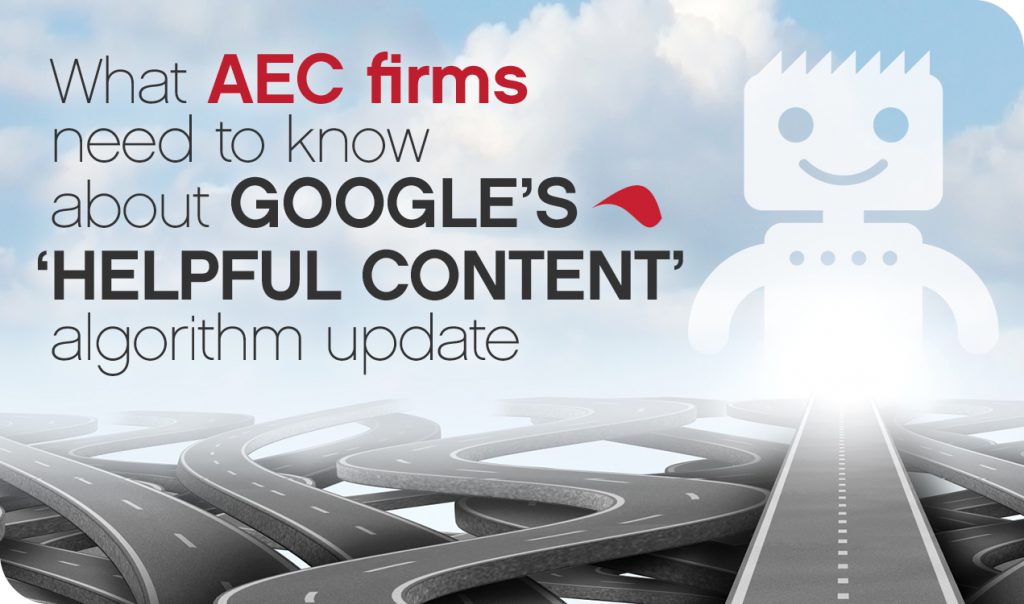What AEC firms need to know about Google’s ‘helpful content’ algorithm update
Google recently launched a ‘helpful content’ update to its search algorithm to prioritize unique and thorough content for its users. Conversely, it will automatically identify content that seems to have little value, low added value or is otherwise not particularly helpful to those performing the searches. When it identifies what it considers deficient pages and websites, it automatically moves them to the bottom of the search results. Think of it as a way for the search engine to separate the wheat from the chaff in the infinite web of information (and misinformation) that is the internet.
For those in the architecture, engineering and construction industries, particularly those that partake in B2B marketing and thought leadership, the update could mean fewer users will see your content if it’s not up to snuff. Cue the panic amongst content creators and SEO marketers.
Content creators after the rollout
How will Google determine which websites contain people-first content?
The process isn’t arbitrary. There isn’t a team of wizened (possibly biased) internet gurus reviewing websites and ranking their content to determine which ones are a value-add for the search engine’s users. The “helpful content” classifier process is automated, using a machine-learning model. It’s just the latest of many signals Google evaluates to rank content.
What should AEC firms do to ensure their websites and content perform better?
Since the update focuses on people-first content and rewards content where visitors feel they’ve had a satisfying experience, AEC firms should review existing content under this lens. If you’re unfamiliar with user experience (UX) design, learning more about this website design approach would be an excellent place to start, as it allows companies to design websites that provide meaningful and relevant experiences to their users.
Recommendations for implementing a people-first approach:
- Determine your site’s primary purpose or focus, then stick to it. Delete content that takes away from that objective or dilutes your message.
- Identify your business or site’s intended audience, then create content they would find helpful. Adding original pictures and videos will also influence the way the algorithm impacts your traffic.
- Be consistent. Shift your marketing mindset toward knowledge extraction and you will find there is far more to share than the occasional press release. AEC firms should get into the practice of answering their clients’ questions through content on their website in the form of blogs, articles, infographics, ebooks, videos, etc.
- Ask yourself, after reading your content, will someone leave feeling they’ve learned enough about a topic to help achieve their goal?
- Demonstrate first-hand industry expertise and a depth of knowledge on relevant topics. You can do this by engaging your employees in thought leadership topic development and execution. Think of them as an extension of your marketing strategy and capabilities.
- Make sure every page of your website is helpful, functional and well-maintained.
- Honestly evaluate whether someone visiting your website will leave feeling like they’ve had a satisfying experience. Content that doesn’t meet a visitor’s expectations won’t perform as well.
Biggest pitfalls to avoid
Google warns against focusing solely on creating content for search engines. According to the search engine, people-first content creators focus primarily on creating satisfying content while utilizing SEO best practices to bring searchers additional value. It’s not a mutually exclusive strategy. You should still follow SEO best practices but keep them from leading the content you create. Think of it as an added layer… like a cake anyone would want to devour.
Recommendations for avoiding a search engine-first approach:
- Don’t try to cast a wide net and produce lots of content on various topics in hopes that some of it might perform well in search results.
- Avoid extensive automation as it is not perceived to be authentic.
- Avoid summarizing what others have to say without adding much value. If you’re not an authority on the topic, it’s best to refocus your energy on your field of expertise.
- Don’t let trends derail you from pursuing your focus. If it’s not pertinent to your audience, leave it be.
- Avoid content that leaves your users with more questions than answers. If they have to Google what you’re talking about, you need to explain it better.
- Keep in mind that Google does not have a preferred word count. Engaging content trumps lengthy tirades or forced word limits.
Why time is of the essence when adapting to the new ‘helpful content’ classifier process
If your online focus has always been to create people-first content, then you’re golden. But, if that’s not the case, prioritize restructuring your website. Begin by creating pages that align with your new “helpful content” strategy. For instance, if a potential client is seeking an AEC firm with extensive K-12 school experience, and your firm doesn’t have many project examples or articles about best practices on building K-12 schools, then you’ll likely be passed over in their search for a firm that does. Build a robust project portfolio that will get you noticed.
Lastly, don’t wait long because the update is already in effect. Second-rate websites (and their faulty content) are dropping to the bottom of search results as I type. Luckily, Google’s classifier for this update runs continuously, allowing it to monitor newly launched sites and existing ones. As it determines that the unhelpful content has not returned to a website in the long term, the “unhelpful” classification will no longer apply.
For more information on improving your website, check out Google’s additional guidance on building a high-quality, high-performing website.
Still have questions about how to navigate Google’s “helpful content” update? Email me at info@rep-ink.com.









